Özel gönderi türleri, standart gönderi ve sayfaların ötesine geçmenizi sağlar. Sitenizin özel ihtiyaçlarına göre uyarlanmış çeşitli içerik türleri oluşturmanızı sağlarlar.
Örneğin, özel yazı türleri WordPress sitenizi basit bir blog platformundan sağlam bir içerik yönetim sistemine(CMS) dönüştürmenizi sağlar.
Bu yüzden kendi web sitelerimizde bazı özel yazı türleri kullanıyoruz. Bu kılavuzda, WordPress’te özel yazı türlerini nasıl kolayca oluşturacağınızı göstereceğiz.

WordPress’te Özel Yazı Türü Nedir?
WordPress web sitenizde, yazı türleri WordPress’teki farklı içerik türlerini ayırt etmeye yardımcı olmak için kullanılır. Yazılar ve sayfaların her ikisi de yazı türüdür ancak farklı amaçlara hizmet etmek için yapılmıştır.
WordPress varsayılan olarak birkaç farklı yazı türüyle birlikte gelir:
- Posta
- Sayfa
- Eklenti
- Revizyon
- Nav Menüsü
Bununla birlikte, özel gönderi türleri olarak bilinen kendi gönderi türlerinizi oluşturabilirsiniz. Bunlar, standart bir gönderi veya sayfadan farklı bir biçime sahip içerik oluştururken kullanışlıdır.
Diyelim ki bir film inceleme sitesi işletiyorsunuz. O zaman muhtemelen bir ‘film incelemeleri’ gönderi türü oluşturmak istersiniz. Ayrıca portföyler, referanslar, ürünler ve daha fazlası için özel gönderi türleri de oluşturabilirsiniz.
Ayrıca, özel gönderi türleri farklı özel alanlara ve kendi özel kategori yapılarına sahip olabilir.
Örneğin WPBeginner’da, günlük blog makalelerimizden ayrı tutmak için Fırsatlar ve Sözlük bölümlerimiz için özel gönderi türleri kullanıyoruz. Bu, web sitesi içeriğimizi daha iyi düzenlememize yardımcı oluyor.
Birçok popüler WordPress eklentisi, WordPress web sitenizde veri depolamak için özel yazı türlerini kullanır. Aşağıda özel gönderi türlerini kullanan en iyi birkaç eklenti yer almaktadır:
- WooCommerce çevrimiçi mağazanıza bir ‘ürün’ gönderi türü ekler
- WPForms, tüm formlarınızı saklamak için bir ‘wpforms’ yazı türü oluşturur
- MemberPress ‘e ‘memberpressproduct’ özel yazı türü eklendi
Video Eğitimi
Yazılı talimatları tercih ediyorsanız, okumaya devam edin.
Özel Yazı Türleri Oluşturmam Gerekiyor mu?
WordPress sitenizde özel yazı türleri oluşturmaya başlamadan önce ihtiyaçlarınızı değerlendirmeniz önemlidir. Genellikle aynı sonuçları normal bir yazı veya sayfa ile de elde edebilirsiniz.
Sitenizin özel gönderi türlerine ihtiyacı olup olmadığından emin değilseniz, WordPress’te özel bir gönderi türüne veya taksonomiye ne zaman ihtiyacınız olduğuna ilişkin kılavuzumuza bakın.
Bunu akılda tutarak, WordPress’te kendi kullanımınız için özel yazı türlerini nasıl kolayca oluşturabileceğinize bir göz atalım. Size iki yöntem göstereceğiz ve ayrıca WordPress web sitenizde özel yazı türlerini görüntülemenin bazı yollarını ele alacağız:
Hazır mısınız? Hadi başlayalım.
WPCode Kullanarak Manuel Olarak Özel Yazı Türü Oluşturma
Özel bir gönderi türü oluşturmak için temanızın functions.php dosyasına kod eklemeniz gerekir. Ancak bunu ileri düzey kullanıcılar dışında kimseye önermiyoruz çünkü küçük bir hata bile sitenizi bozabilir. Ayrıca, temanızı güncellerseniz kod silinecektir.
Bunun yerine, WordPress web sitenize özel kod eklemenin en kolay ve en güvenli yolu olan WPCode’u kullanacağız.
WPCode ile özel snippet’ler ekleyebilir ve yerleşik, önceden yapılandırılmış kod kütüphanesinden birçok özelliği etkinleştirebilirsiniz. Başka bir deyişle, yüklemiş olabileceğiniz birçok özel veya tek kullanımlık eklentinin yerini alabilir.
Öncelikle, ücretsiz WPCode eklentisini yüklemeniz ve etkinleştirmeniz gerekecektir. Ayrıntılı talimatlar için bir WordPress eklentisinin nasıl kurulacağına ilişkin adım adım kılavuzumuza göz atın.
Etkinleştirildikten sonra, WordPress panonuzdan Kod Parçacıkları “ Parçacık Ekle ‘ye gidin. Ardından, farenizi ‘Özel Kodunuzu Ekleyin (Yeni Snippet)’ seçeneğinin üzerine getirin ve ardından ‘Snippet Kullan’ seçeneğine tıklayın.
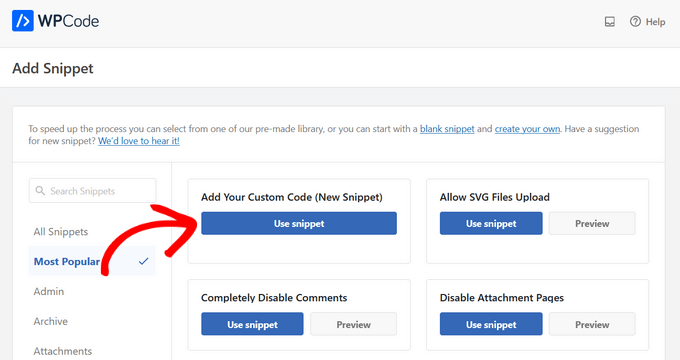
Bu, ‘Özel Snippet Oluştur’ ekranını açacaktır.
Şimdi, kod parçacığı başlığını oluşturabilir ve anahtarı ‘Etkin’ olarak değiştirebilirsiniz.
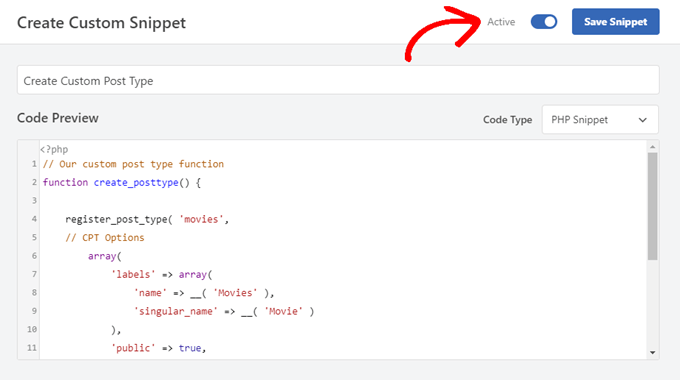
Bundan sonra, aşağıdaki kodu ‘Kod Önizleme’ alanına yapıştırmanız yeterlidir. Bu kod, yönetici kenar çubuğunuzda görünecek ve herhangi bir temayla çalışacak ‘Filmler’ adlı temel bir özel gönderi türü oluşturur.
1 2 3 4 5 6 7 8 9 10 11 12 13 14 15 16 17 18 19 20 | // Our custom post type functionfunction create_posttype() { register_post_type( 'movies', // CPT Options array( 'labels' => array( 'name' => __( 'Movies' ), 'singular_name' => __( 'Movie' ) ), 'public' => true, 'has_archive' => true, 'rewrite' => array('slug' => 'movies'), 'show_in_rest' => true, ) );}// Hooking up our function to theme setupadd_action( 'init', 'create_posttype' ); |
Yalnızca temel bir özel gönderi türü istiyorsanız, Filmler ve Filmler ‘i kendi CPT slug’ınız ve adınızla değiştirin ve ‘Güncelle’ düğmesine tıklayın.
Ancak, özel gönderi türünüz için daha fazla seçenek istiyorsanız, yukarıdaki kod yerine aşağıdaki kodu kullanmalısınız.
Aşağıdaki kod ‘Filmler’ özel gönderi türüne revizyonlar, öne çıkan görseller ve özel alanlar için destek gibi daha birçok seçenek eklemenin yanı sıra özel gönderi türünü ‘türler’ adlı özel bir taksonomiyle ilişkilendirir.
Not: Bu iki snippet’i birleştirmeyin, aksi takdirde her iki snippet de aynı özel yazı türünü kaydettiğinden WordPress size hata verecektir. Kaydetmek istediğiniz her ek yazı türü için WPCode kullanarak tamamen yeni bir snippet oluşturmanızı öneririz.
1 2 3 4 5 6 7 8 9 10 11 12 13 14 15 16 17 18 19 20 21 22 23 24 25 26 27 28 29 30 31 32 33 34 35 36 37 38 39 40 41 42 43 44 45 46 47 48 49 50 51 52 53 54 55 56 57 58 59 60 61 62 63 64 | /** Creating a function to create our CPT*/ function custom_post_type() { // Set UI labels for Custom Post Type $labels = array( 'name' => _x( 'Movies', 'Post Type General Name', 'twentytwentyone' ), 'singular_name' => _x( 'Movie', 'Post Type Singular Name', 'twentytwentyone' ), 'menu_name' => __( 'Movies', 'twentytwentyone' ), 'parent_item_colon' => __( 'Parent Movie', 'twentytwentyone' ), 'all_items' => __( 'All Movies', 'twentytwentyone' ), 'view_item' => __( 'View Movie', 'twentytwentyone' ), 'add_new_item' => __( 'Add New Movie', 'twentytwentyone' ), 'add_new' => __( 'Add New', 'twentytwentyone' ), 'edit_item' => __( 'Edit Movie', 'twentytwentyone' ), 'update_item' => __( 'Update Movie', 'twentytwentyone' ), 'search_items' => __( 'Search Movie', 'twentytwentyone' ), 'not_found' => __( 'Not Found', 'twentytwentyone' ), 'not_found_in_trash' => __( 'Not found in Trash', 'twentytwentyone' ), ); // Set other options for Custom Post Type $args = array( 'label' => __( 'movies', 'twentytwentyone' ), 'description' => __( 'Movie news and reviews', 'twentytwentyone' ), 'labels' => $labels, // Features this CPT supports in Post Editor 'supports' => array( 'title', 'editor', 'excerpt', 'author', 'thumbnail', 'comments', 'revisions', 'custom-fields', ), // You can associate this CPT with a taxonomy or custom taxonomy. 'taxonomies' => array( 'genres' ), /* A hierarchical CPT is like Pages and can have * Parent and child items. A non-hierarchical CPT * is like Posts. */ 'hierarchical' => false, 'public' => true, 'show_ui' => true, 'show_in_menu' => true, 'show_in_nav_menus' => true, 'show_in_admin_bar' => true, 'menu_position' => 5, 'can_export' => true, 'has_archive' => true, 'exclude_from_search' => false, 'publicly_queryable' => true, 'capability_type' => 'post', 'show_in_rest' => true, ); // Registering your Custom Post Type register_post_type( 'movies', $args ); } /* Hook into the 'init' action so that the function* Containing our post type registration is not * unnecessarily executed. */ add_action( 'init', 'custom_post_type', 0 ); |
Hiyerarşik değeri false olarak ayarladığımız kısmı fark etmişsinizdir. Özel yazı türünüzün yazılar yerine sayfalar gibi davranmasını istiyorsanız, bu değeri true olarak ayarlayabilirsiniz.
Dikkat edilmesi gereken bir diğer husus da twentytwentyone dizesinin tekrar tekrar kullanılmasıdır, buna ‘Metin Alanı’ denir. Temanız çeviriye hazırsa ve özel gönderi türlerinizin çevrilmesini istiyorsanız, temanız tarafından kullanılan metin alanını belirtmeniz gerekecektir.
Temanızın metin alanını tema dizininizdeki style.css dosyasının içinde veya yönetici panelinizdeki Görünüm “ Tema Dosyası Düzenleyicisi ‘ne giderek bulabilirsiniz. Metin alanı dosyanın başlığında belirtilecektir.
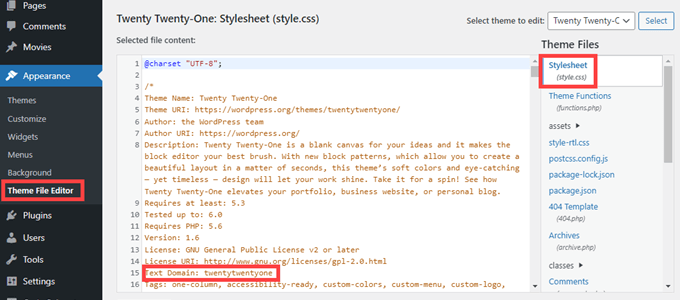
Twentytwentyone yerine kendi temanızın ‘Metin Alanı’nı yazmanız yeterlidir.
Değişikliklerden memnun olduğunuzda, ‘Güncelle’ düğmesine tıklamanız yeterlidir; gerisini WPCode halledecektir.
Eklenti ile Özel Yazı Türü Oluşturma
WordPress’te özel bir yazı türü oluşturmanın bir diğer kolay yolu da bir eklenti kullanmaktır. Bu yöntem yeni başlayanlar için önerilir çünkü güvenli ve süper kolaydır.
Yapmanız gereken ilk şey Custom Post Type UI eklentisini yüklemek ve etkinleştirmektir. Daha fazla ayrıntı için, bir WordPress eklentisinin nasıl kurulacağına ilişkin adım adım kılavuzumuza bakın.
Etkinleştirmenin ardından, yeni bir özel gönderi türü oluşturmak için CPT UI ” Gönderi Türleri Ekle / Düzenle ‘ye gitmeniz gerekir. ‘Yeni Yazı Türü Ekle’ sekmesinde olmalısınız.
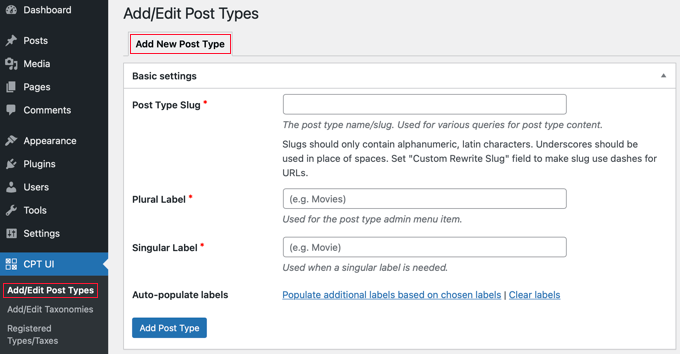
Bu alanda, özel gönderi türünüz için ‘filmler’ gibi bir slug sağlamanız gerekir. Bu slug URL’de ve WordPress sorgularında kullanılacağından yalnızca harf ve rakam içerebilir.
Slug alanının altında, özel gönderi türünüz için çoğul ve tekil adları sağlamanız gerekir.
İsterseniz, ‘Seçilen etiketlere göre ek etiketleri doldur’ yazan bağlantıya tıklayabilirsiniz. Bu, aşağıdaki ek etiket alanlarını otomatik olarak dolduracak ve genellikle size zaman kazandıracaktır.
Şimdi aşağı kaydırarak ‘Ek Etiketler’ bölümüne gidebilirsiniz. Bahsettiğimiz bağlantıya tıklamadıysanız, gönderi türünüz için bir açıklama sağlamanız ve etiketleri değiştirmeniz gerekecektir.
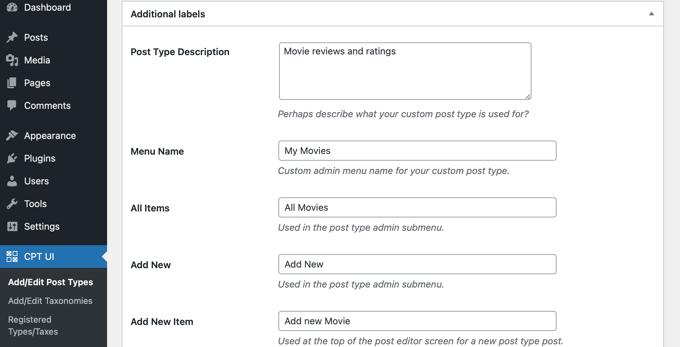
Bu etiketler, söz konusu yazı türündeki içeriği yönetirken WordPress kullanıcı arayüzü boyunca kullanılacaktır.
Daha sonra gönderi türü ayarları gelir. Buradan, gönderi türünüz için farklı nitelikler ayarlayabilirsiniz. Her seçenek, ne işe yaradığını açıklayan kısa bir açıklama ile birlikte gelir.
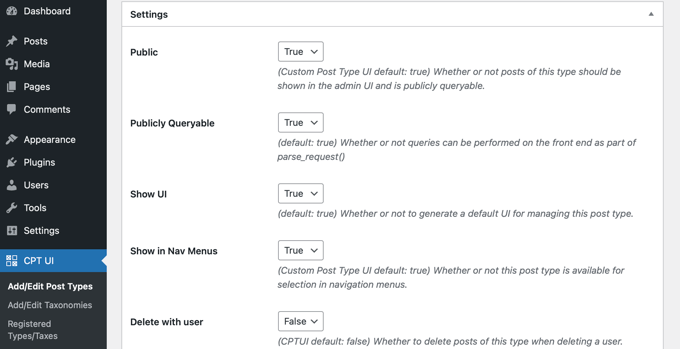
Örneğin, bir gönderi türünü sayfalar gibi hiyerarşik yapmamayı veya kronolojik gönderileri tersten sıralamayı seçebilirsiniz.
Genel ayarların altında, bu gönderi türünün hangi düzenleme özelliklerini destekleyeceğini seçme seçeneğini göreceksiniz. Dahil edilmesini istediğiniz seçenekleri işaretlemeniz yeterlidir.
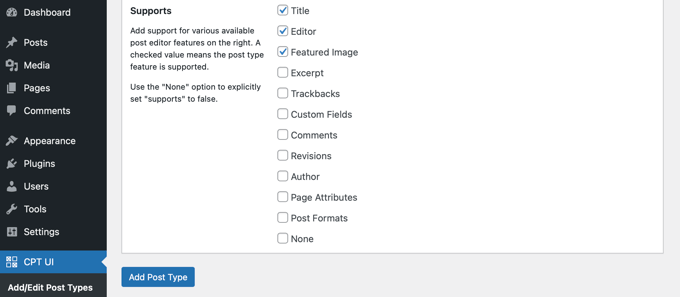
Son olarak, kaydetmek ve özel gönderi türünüzü oluşturmak için ‘Gönderi Türü Ekle’ düğmesine tıklayın.
Hepsi bu kadar, özel gönderi türünüzü başarıyla oluşturdunuz! Artık devam edebilir ve içerik eklemeye başlayabilirsiniz.
Sitenizde Özel Yazı Türlerini Görüntüleme
WordPress, özel yazı türlerinizi görüntülemek için yerleşik destekle birlikte gelir. Yeni özel yazı türünüze birkaç öğe ekledikten sonra, bunları web sitenizde görüntülemenin zamanı geldi.
Kullanabileceğiniz birkaç yöntem vardır ve her birinin kendine özgü faydaları vardır.
Varsayılan Arşiv Şablonunu Kullanarak Özel Yazı Türlerini Görüntüleme
İlk olarak, Görünüm ” Menüler bölümüne gidebilir ve menünüze özel bir bağlantı ekleyebilirsiniz. Bu özel bağlantı, özel gönderi türünüzün bağlantısıdır.
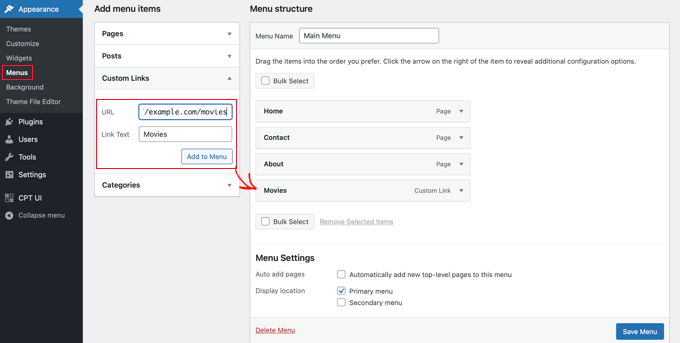
SEO dostu kalıcı bağlantılar kullanıyorsanız, özel gönderi türünüzün URL’si büyük olasılıkla buna benzer bir şey olacaktır:
http://example.com/movies |
SEO dostu kalıcı bağlantılar kullanmıyorsanız, özel gönderi türü URL’niz buna benzer bir şey olacaktır:
http://example.com/?post_type=movies |
‘example.com’ yerine kendi alan adınızı ve ‘movies’ yerine özel gönderi türü adınızı yazmayı unutmayın.
Daha sonra menünüzü kaydedebilir ve web sitenizin ön ucunu ziyaret edebilirsiniz. Eklediğiniz yeni menü öğesini göreceksiniz ve üzerine tıkladığınızda, temanızdaki archive.php şablon dosyasını kullanarak özel yazı türünüzün arşiv sayfasını görüntüleyecektir.

Özel Yazı Tipi Şablonları Oluşturma
Özel gönderi türünüz için arşiv sayfasının görünümünü beğenmiyorsanız, özel gönderi türü arşivleri için özel bir şablon kullanabilirsiniz.
Tek yapmanız gereken tema dizininizde yeni bir dosya oluşturmak ve adını archive-movies.php koymak. ‘movies’ yerine özel gönderi türünüzün adını yazdığınızdan emin olun.
Başlamak için temanızın archive.php dosyasının içeriğini archive-movies.php şablonuna kopyalayabilir ve ardından ihtiyaçlarınızı karşılayacak şekilde değiştirebilirsiniz.
Artık, özel gönderi türünüzün arşiv sayfasına her erişildiğinde, bu şablon onu görüntülemek için kullanılacaktır.
Benzer şekilde, yazı türünüzün tek girişli gösterimi için özel bir şablon oluşturabilirsiniz. Bunu yapmak için tema dizininizde single-movies.php dosyasını oluşturmanız gerekir. ‘movies’ yerine özel gönderi türünüzün adını yazmayı unutmayın.
Temanızın single .php şablonunun içeriğini single-movies.php şablonuna kopyalayarak ve ardından ihtiyaçlarınızı karşılayacak şekilde değiştirerek başlayabilirsiniz.
Daha fazla bilgi edinmek için WordPress’te özel tekli yazı şablonlarının nasıl oluşturulacağına ilişkin kılavuzumuza bakın.
Özel Yazı Türlerini Ön Sayfada Görüntüleme
Özel gönderi türlerini kullanmanın bir avantajı, özel içerik türlerinizi normal gönderilerinizden ayrı tutmasıdır. Bununla birlikte, isterseniz özel gönderi türlerini web sitenizin ön sayfasında görüntüleyebilirsiniz.
Ücretsiz WPCode eklentisini kullanarak bu kodu yeni bir snippet olarak eklemeniz yeterlidir. Ayrıntılı talimatlar için lütfen bu makalenin manuel olarak kod ekleme bölümüne bakın.
1 2 3 4 5 6 7 | add_action( 'pre_get_posts', 'add_my_post_types_to_query' ); function add_my_post_types_to_query( $query ) { if ( is_home() && $query->is_main_query() ) $query->set( 'post_type', array( 'post', 'movies' ) ); return $query;} |
‘movies’ yerine özel gönderi türünüzü yazmayı unutmayın.
Özel Gönderi Türlerini Sorgulama
Kodlamaya aşina iseniz ve şablonlarınızda döngü sorguları çalıştırmak istiyorsanız, bunu nasıl yapacağınız aşağıda açıklanmıştır. Veritabanını sorgulayarak, özel bir gönderi türünden öğeleri alabilirsiniz.
Aşağıdaki kod parçacığını özel gönderi türünü görüntülemek istediğiniz şablona kopyalamanız gerekecektir.
1 2 3 4 5 6 7 8 9 10 11 12 13 14 15 | <?php $args = array( 'post_type' => 'movies', 'posts_per_page' => 10 );$the_query = new WP_Query( $args ); ?><?php if ( $the_query->have_posts() ) : ?><?php while ( $the_query->have_posts() ) : $the_query->the_post(); ?><h2><?php the_title(); ?></h2><div class="entry-content"><?php the_content(); ?> </div><?php endwhile;wp_reset_postdata(); ?><?php else: ?><p><?php _e( 'Sorry, no posts matched your criteria.' ); ?></p><?php endif; ?> |
Bu kod, yeni WP_Query sınıfımız için argümanlarda gönderi türünü ve sayfa başına gönderi sayısını tanımlar. Daha sonra sorguyu çalıştırır, gönderileri alır ve bunları döngü içinde görüntüler.
Widget’larda Özel Yazı Türlerini Görüntüleme
WordPress’in son gönderileri görüntülemek için varsayılan bir widget’a sahip olduğunu, ancak özel bir gönderi türü seçmenize izin vermediğini fark edeceksiniz.
Peki ya yeni oluşturduğunuz yazı türündeki en son girdileri bir widget’ta görüntülemek isterseniz? Neyse ki bunu yapmanın kolay bir yolu var.
Yapmanız gereken ilk şey Custom Post Type Widgets eklentisini yüklemek ve etkinleştirmektir. Daha fazla ayrıntı için WordPress eklentisi yükleme hakkındaki adım adım kılavuzumuza bakın.
Etkinleştirmenin ardından Görünüm ” Widget ‘lar bölümüne gidin ve ‘Son Yazılar (Özel Yazı Türü)’ widget’ını sürükleyip kenar çubuğuna bırakın.
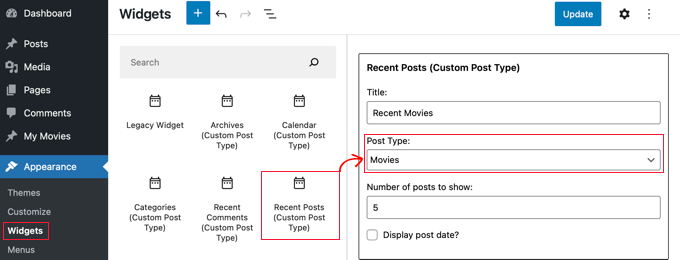
Bu widget, herhangi bir gönderi türünden son gönderileri göstermenizi sağlar. ‘Yazı Türü’ açılır menüsünden özel yazı türünüzü seçmeniz ve istediğiniz seçenekleri belirlemeniz gerekir.
Bundan sonra, ekranın üst kısmındaki ‘Güncelle’ düğmesine tıkladığınızdan emin olun ve ardından widget’ı çalışırken görmek için web sitenizi ziyaret edin.

Eklenti ayrıca arşivleri, takvimi, kategorileri, son yorumları, aramayı ve etiket bulutunu görüntüleyen özel yazı tipi widget’ları sağlar.
Bu nedenle, keşfetmekten ve ihtiyacınız olanı seçmekten çekinmeyin.
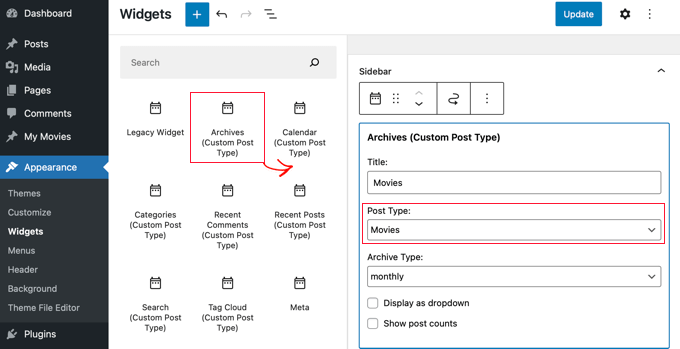
Umarız bu eğitim WordPress’te özel yazı türlerinin nasıl oluşturulacağını öğrenmenize yardımcı olmuştur. Daha sonra, WordPress’te özel bir arşiv sayfasının nasıl oluşturulacağını öğrenmek veya her WordPress blogunun sahip olması gereken önemli sayfalar listemize göz atmak isteyebilirsiniz.
If you liked this article, then please subscribe to our YouTube Channel for WordPress video tutorials. You can also find us on Twitter and Facebook.





Anna
Good stuff! TY!
Is it possible to select a category for the CPT or create it’s own category list?
In your example of ‘Movies’ – select which category – Family, Drama, Action, etc?
WPBeginner Support
You can place the custom post types in a category, we have our article below that goes more in-depth on how to set that up
https://www.wpbeginner.com/wp-tutorials/how-to-add-categories-to-a-custom-post-type-in-wordpress/
Admin
Michelle
Hi! How can I set the query to only display custom post types by category on the category page? Currently, my query pulls ALL the post type, and I can’t seem to get just current category to display. thanks
WPBeginner Support
For customizing your search results, we would recommend taking a look at our guide below!
https://www.wpbeginner.com/wp-tutorials/how-to-create-advanced-search-form-in-wordpress-for-custom-post-types/
Admin
hussain
I have used this method which you explained above, but after creating a new menu, menu has created successfully created but when I click my menu it shows me error that “This page could not foun”
WPBeginner Support
It sounds like you would need to check and resave your permalinks to be safe. The other thing you could do would be to ensure you have a custom post type published for be found on the page.
Admin
Jarkko
So I used Code Snippets and the longer code but the features after ‘supports’ are not visible anywhere? Shouldn’t they be visible when clicking “Add new”… How do I insert a new movie and the information of it… I don’t get it.
WPBeginner Support
There should be a new section in your admin area where you can add new posts of your custom post type similar to how you add posts or pages.
Admin
Hafeez Ulllah
How cn display custom post type and where the code of display will be pasted
Johan
Seems to work perfectly, except for one thing: My theme is showing featured images on the pages. But when I use the CPT the images are never show, whatever I do. Any idea why?
WPBeginner Support
Your theme likely has a different template being used, if you reach out to your theme’s support they should be able to assist.
Admin
D Hebing
I tried many things with the code above, even compare it with the twintytwintyone theme of wordpress. But the post types don’t appear in the backend in the post editor.
WPBeginner Support
If none of the methods work for you, you would want to go through our troubleshooting steps below for finding the cause of the issue:
https://www.wpbeginner.com/beginners-guide/beginners-guide-to-troubleshooting-wordpress-errors-step-by-step/
Admin
Aurelien
5 years on, still useful! Thank you guys
WPBeginner Support
Glad you’ve found our content helpful
Admin
Max
Thanks very useful.
What do you think? In such cases from view of site speed it is better to install the plugin or write the code you provide?
WPBeginner Support
There shouldn’t be a difference in speed with either method being used.
Admin
Marshal Tudu
Thanks a lot for the help. I am trying to create a movie database on my website
Your post really helped me.
WPBeginner Support
Glad our guide was helpful
Admin
Harsha
How to migrate old posts to the new post type?
WPBeginner Support
You would want to use the plugin from our guide below:
https://www.wpbeginner.com/plugins/how-to-convert-post-types/
Admin
Leslie Campos
Great article! I tried to add two different post types on top of blog posts but the second add_action( ‘init’, ‘create_posttype’ ); overwrote the first one. I don’t know php but am wondering if it is possible to create two different ones in the same functions.php file. I don’t know php so perhaps it’s the way I am writing it?
WPBeginner Support
We would recommend using the plugin method to make the process easier. For a second post type with the code, you would need to copy from lines 4 to 17 and paste it on a new line below 17 then rename movies to a different name.
Admin
Girish Sahu
Really loved the article, Simple explained and was really of great help.
I wanted to mix custom posts and blogs post in a single page and was able to do so after reading the article.
WPBeginner Support
Glad our guide was helpful
Admin
Rafiozoo
Great recipe! Thank you!
One question:
‘exclude_from_search’ => true
should exclude my new custom posts from search results, I believe. Why does not work?
WPBeginner Support
It would depend on the search being used, you may want to take a look at our guide below:
https://www.wpbeginner.com/wp-tutorials/how-to-exclude-pages-from-wordpress-search-results/
Admin
snelson
Is there a way to display the new post type without the new slug? example. Default is mysite.com/newposttype/newpage
I would like
mysite.com/newpage/
WPBeginner Support
For customizing your permalinks, you would want to take a look at our article below:
https://www.wpbeginner.com/wp-tutorials/how-to-create-custom-permalinks-in-wordpress/
Admin
Yogesh
Hi,
I tried to use the manual approach using the simple code youve mentioned for creating a custom post type, but unfortunatley the posts dont show up (page not found error). The post permalink structure looks fine but the posts dont get displayed.
WPBeginner Support
You may want to clear the cache for your site and resave your permalinks to clear that issue.
Admin
rajni
hey thank you so much it working fine but i want to show post type on a page where only categories will show and when click on category post listed under this category will open can you please suggest me how to do that.thank you in advance
WPBeginner Support
For what it sounds like you’re wanting, you would want to ensure that categories are enabled for your custom post type and you could then add the category link in your menu for the page listing them how you want
Admin
G'will Chijioke
Hi, i am a newbie developer trying to create a custom post type.
All is good, just 1 huge problem.
I want to display the taxonomies that i created and linked to the post (tags and categories ) on the post itself.
i want to show it on my breadcrumbs as well.
pls it would mean d world if you helped me out.
Thanks in advance.
WPBeginner Support
Displaying the tags and categories would require you editing your theme’s template if your theme does not show that currently.
For breadcrumbs, if you’re using a plugin most should detect your taxonomy and give you options: https://www.wpbeginner.com/plugins/how-to-display-breadcrumb-navigation-links-in-wordpress/
Admin
rana ritesh singh
nice post
WPBeginner Support
Thank you
Admin
Haibatan
I want a CPT for my english posts, my site is in an RTL language, is it possible?
WPBeginner Support
You certainly could, you can also take a look at multilingual plugins such as the one in our article: https://www.wpbeginner.com/beginners-guide/how-to-easily-create-a-multilingual-wordpress-site/
Admin
RZKY
One question, in the default WP post dashboard, there’s a filter by categories feature on top of the list.
So I already link my custom post type with a custom taxonomy, but the filter menu is not showing (A portfolio post type, and the portfolio category custom taxonomy). Is there any settings i need to enable? I’m doing this from inside my functions.php
WPBeginner Support
Hi,
in your custom taxonomy function set ‘show_admin_column’ to true
Admin
Feras
Hi there, So “Custome post type UI” is not compatible with my wp version! is there any useful plugin that I CAN USE
Oscar
Hi!. I want to ask you something.
I created a Custom Post Types.
But when i create a post, there isnt the options “Page Attributes”, to choose the template and order the posts.
How can I get it?
Thanks in advanced.
Syed Furqan Ali
Hi Oscar,
If you are using the CPT UI plugin to create custom post types, you’ll need to ensure that you enable the “Page Attributes” option under the “Supports” section. This will allow you to assign parent pages to your custom post types. Similarly, if you are using custom code to create custom post types, make sure to include the “page-attributes” in the supports parameter to enable this feature.
vinay
post is created but custom fields are not showing why?/
Kevin
I’ve created a CPT with unique archive page, but I would like to be able to show a featured image for the archive page (not from the first post) but as the archive page doesn’t exist in “pages” there is no way to add the featured image
how would this be achieved ?
Juno
Is it possible to access these custom post types via WP REST API? If so how? (for GET, POST, etc.
Mottaqi
I want a custom post type page that will be open from archive.php page with all it’s posts and under this page I want to place it’s all posts as sub menu items. But when I create a custom link page and place it’s sub menu items as I describe, sum menu url will open but my main archive page , I mean that post type page url will disappear.
Plz I want to access both pages.. But how…?
Steven Denger
Will adding Custom Post Types allow me to have another posting page for these? My regular Home page has products running through that. I need an additonal posting page for product reviews. When I create a review, I need it to post on another feature page. Is this what tis is for?
utkarsh
nevermind that last question i asked read your whole article and got it
utkarsh
Hey what does ‘twentythirteen’ in
“_x(‘Movies’, ‘Post Type General Name’, ‘twentythirteen’)”
Jim
Also notice repeated usage of twentythirteen, this is called text domain. If your theme is translation ready and you want your custom post types to be translated, then you will need to mention text domain used by your theme. You can find your theme’s text domain inside style.css file in your theme directory. Text domain will be mentioned in the header of the file.
Angela
Hello and thank you for this post (and several others).
I have created the new custom post type of “stories” and its showing up in my WP dashboard. I can create a new post but when I try to open the Beaver Builder page builder to build the post, it won’t open and goes to “Sorry, this page doesn’t exist” error page.
Can you help?
Thank you,
Angela
WPBeginner Support
Hi Angela,
First, you should try updating your permalinks. Simply visit Settings » Permalinks and then click on the save changes button without changing anything.
If this doesn’t resolve your issue, then contact plugin’s support.
Admin
Angela
Hi and thank you for your reply. I did what you suggested and it didn’t help. My plugin is created using the customer post type code above and is placed in a site-specific plugin, so I have no plugin support source from which to seek help other than you
I deleted the site-specific plugin (which of course included the CPT code) and new posts and pages still won’t load using the Beaver Builder theme page builder function, but they will at least show the page with a large white bar loading endlessly. I deactivated Ultimate Add-ons for Beaver Builder plugin and new posts and pages will now load using page builder. I think there may have been a conflict between UABB plugin and the CPT plugin and now the conflict remains in UABB plugin.
Any suggestions would be much appreciated. I also have put in a request to UABB. Maybe between the two of you, you could help resolve this issue and make note of this conflict for future reference.
JonO
Great site BTW, really really helpful so thanks for creating.
I’m super stuck and have been reading tutorials all over the web and not found the answers I need.
I want to create a user opt-in custom taxonomy (Let’s call it user_interests) that can be used to display a custom list of posts that are unique to that particular user.
User will opt-in to user_interest tags/catergories/whatever during sign up or when editing profile.
Then the WP loop should include these values to display posts
Any ideas, help would be really appreciated, thanks.
Jonathan
How do I get my user/visitors to my site be able to enter information to a form, and have that submitted data be displayed on which ever page or location I like? I want to allow my users be able to submit complaints and have other users able to like/reply to the main complaint submitted.
Am I able to do this with Custom Post Type?
R Davies
You have a syntax error in your second (more detailed) example, code does not work in latest WordPress 7.4.3
) Warning: call_user_func_array() expects parameter 1 to be a valid callback, function ‘custom_post_type’ not found or invalid function name
Any chance of an update / correction?
WPBeginner Support
Hi R Davies,
We checked and it worked perfectly.
Admin
Archit
Is the comma at the end if the supports array (in the options for the custom post type) deliberate?
Robert Stuart
On line 31? Yes, that’s normal PHP code.
“The comma after the last array element is optional and can be omitted. This is usually done for single-line arrays, i.e. array(1, 2) is preferred over array(1, 2, ). For multi-line arrays on the other hand the trailing comma is commonly used, as it allows easier addition of new elements at the end.”
saurabh
How to enable ‘Post Settings’ in Custom_Post_type (using Custom Post Type UI Plugin)?
Arias
Hello, I have been having problems with this plugin.
It has disabled the option to create categories and tags,
I have been looking for an example to place them manually but I still have not found anything.
I am trying to undo if with this method I can fix the problem but I would greatly appreciate your help.
stormonster
In your $args array, on the ‘taxonomies’ index, add ‘category’ and ‘post_tag’.
That should do the trick.
John D
Way too much coding. WordPress need to keep things more simple.
Ilija
This is why I use my own CMS where I can create new post types in a fraction of a second directly through cms itself. Without any coding, unfortunately big agencies want WordPress developers and have to learn it, seems so complicated..
Sarah A
Hi, i’ve succeded to display group of CPT with a specific design in a pop-up when you click on a image like the first one But it opens a new page and when you click out of the pop-up to quit you don’t return to the homepage, and i don’t want that. I want all on the homepage.
I’ve put the code of the CPT to display as the pop-up on “single-chg_projet.php” and open and close the pop-up with javascript. I’ve already tried to put all the code of single-chg_projet.php on the index, but it display nothing. Or i may be failed somewhere. Please help me. Thanks
Ghulam Mustafa
Hi,
Thanks for the great code. Just a minor correction to the code. The endwhile; statement is missing before else: statement in the Querying Custom Post Types section =)
Tony Peterson
THIS! Please update your code to reflect this syntax error as it caused me a bit of heartache until I found Ghulam’s comment. It’s working now.
Arkanum
Yes! True. It’s miss befire wp_reset_postdate();
The cycle while does not end
Azamat
Typo: “When doi I need a custom post type?”
WPBeginner Support
Thanks for notifying us We have updated the article.
We have updated the article.
Admin
Jhon
hey, can you guide me in the process of making a custom glossary like you have on your site?
WPBeginner Support
We use a custom fields and a custom template to display Glossary terms.
Admin
Anil Reddy
I want to create list type for posts in the category page for my website
david ben oren
how do i clone a post type which has a speicifc table in it, i need to create a seperate post type for other tables.
betty
How do I add a custom field to a Post Type?
WPBeginner Support
Please see our guide WordPress Custom Fields 101.
Admin
Megan
I’ve downloaded the plugin and want to add two custom post types. 1. Fanfiction for all of my writings and 2. Fanart for all of my art.
For Fanfiction – I want the ability to link chapters together into a story and be able to upload chapters to a story as I write them.
For Fanart – I’d like to have the focus be on an image (obviously) with a description underneath it
Is this article what I need or this something completely different?
Thanks,
Megan
Zubair Abbas
Hi,
I simply copied the code to my site’s functions.php. The new post type is visible in the dashboard but when I try to see a post after publishing it, a blank page appears. Later I realised that even the default posts are not opening.
When I remove the code from functions.php everything works fine again.
Please help
Thanks,
Zubair Abbas
Jouke Nienhuis
If you see a blank page, it often means that you forgot a character. The fact that you see the posts if you delete your custom code, confirms that you have a typo. Check for semi-colons ” ; ” and the opening and closing brackets.
To see exactly where you made a mistake, you could edit the wp-config file. Look for ERROR REPORTING and set this value to true. After that test again and there you get an error and a line with the omission.
Alex
I have created the CPT and is working beautifully, but Google cannot find it even after updating sitemaps, using SEO plugins or fetching on Google Webmaster Tools. Any thoughts on why is that happening?
WPBeginner Support
It takes Google sometime to start showing new content in search results. Just to be on safe side, check your SEO plugin settings to make sure you are not blocking indexing of your CPTs or CPT archive pages.
Admin
Amunet
Creating Custom Post Type can be easy especially with a plugin. The real trick is to show them on the page. Usually you need quite advanced custom development or theme specific plugins like that for Avada.
Unfortunately there is no universal way to display CPT in WordPress.
WPBeginner Support
Actually, there are straight forward and standard ways to display CPTs in WordPress. We have mentioned one in the article above.
Admin
Jouke Nienhuis
Like the author said, but I will repeat the answer.
In a nutshell create a link in your navigation menu
Advanced answer in a nutshell: create an archive page and a single page
Chuck
Great article. How can you modify single post CPT post info based on the custom taxonomy? For instance:
Date | Author | Series | Book | Topic
This is easy to write but I want to figure out how to display a modified post info if one the missing taxonomy of Series, like:
Date | Author | Book | Topic
Otherwise the default post info displays as:
Date | Author | | Book | Topic